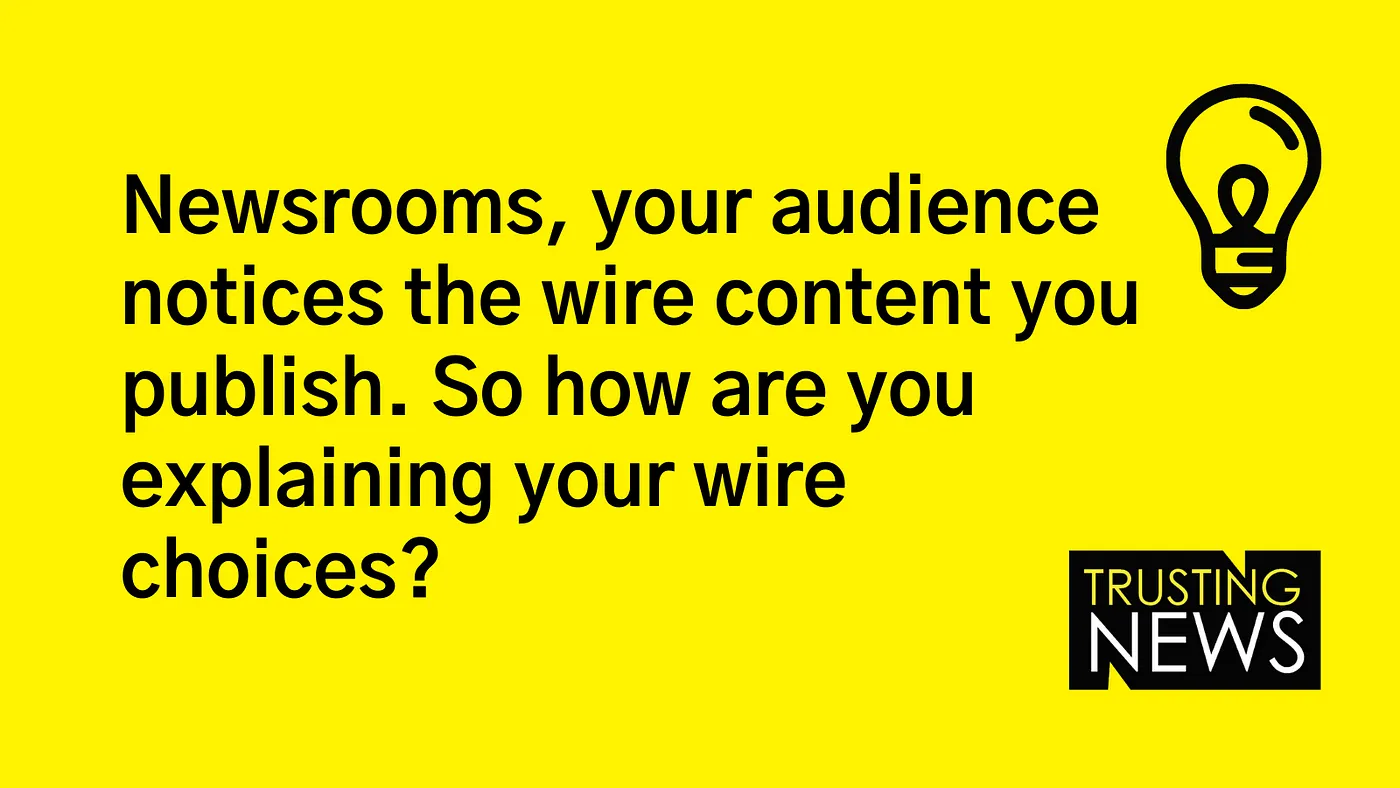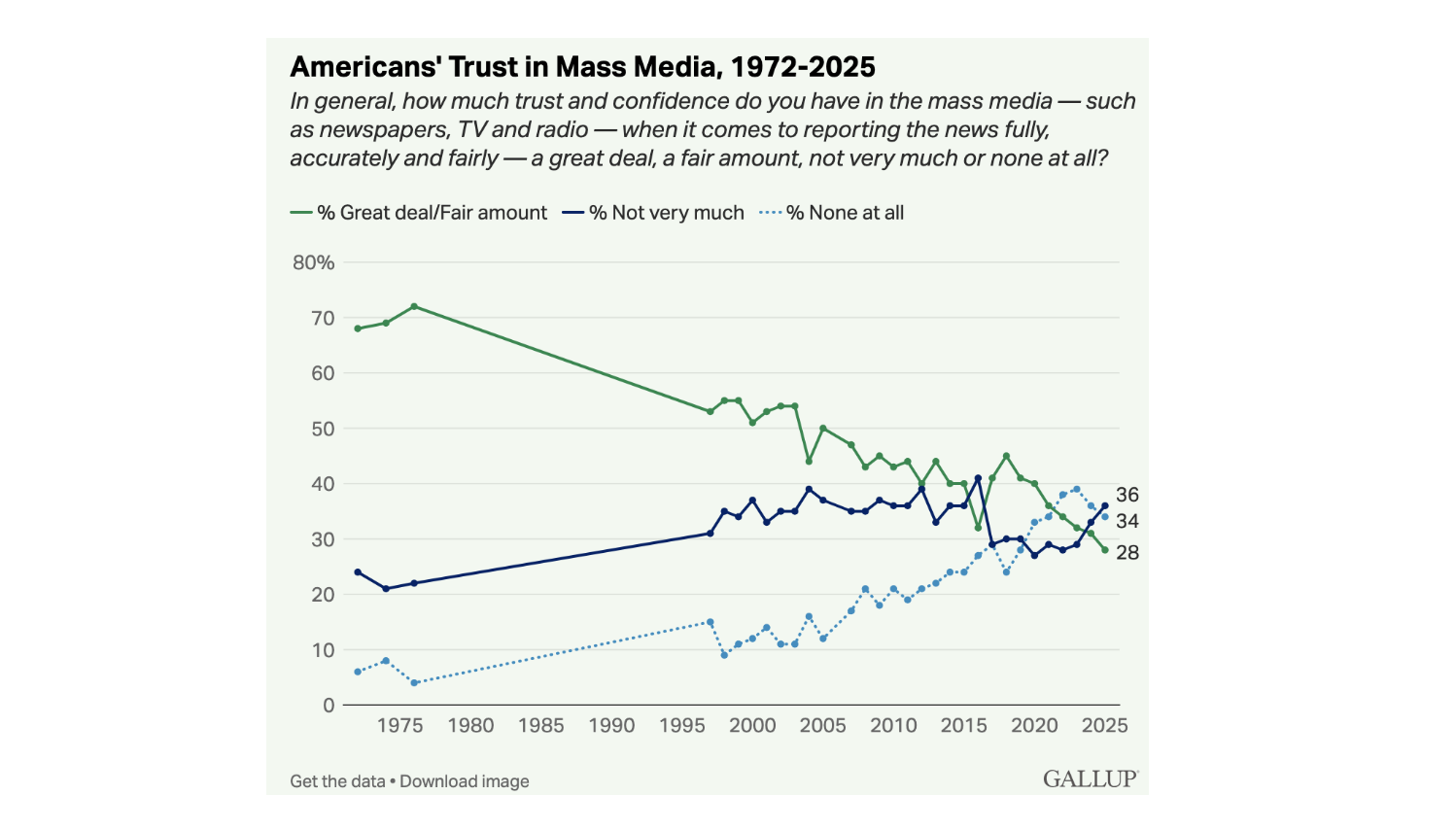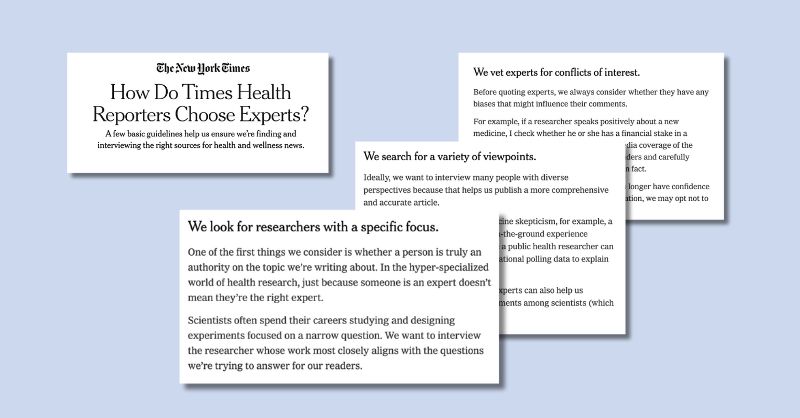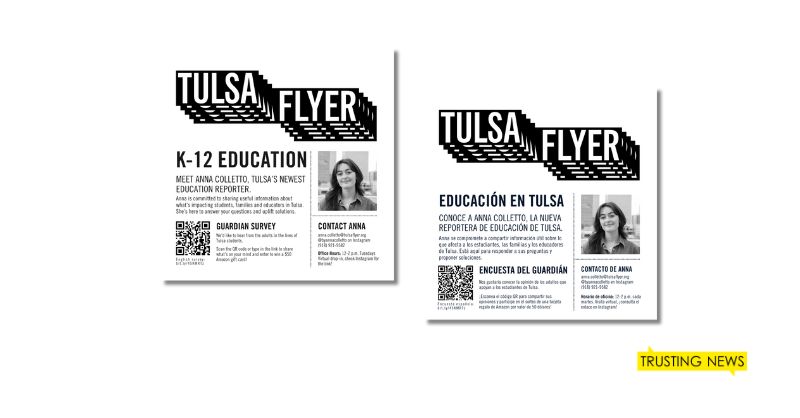
If you’re a journalist who has faced criticism about national coverage published in your new products but not produced by your journalists, you’re not alone. Far from it, actually. We regularly hear from local newsrooms frustrated and overwhelmed by complaints related to the wire coverage they publish. Some local newsrooms we work with have said […]
How newsrooms can better explain (and sometimes edit) wire coverage while being transparent with their audiences
If you’re a journalist who has faced criticism about national coverage published in your new products but not produced by your journalists, you’re not alone.
Far from it, actually. We regularly hear from local newsrooms frustrated and overwhelmed by complaints related to the wire coverage they publish. Some local newsrooms we work with have said most of the accusations of bias they face stem from the wire coverage they run, not local content they produce.
This isn’t necessarily surprising, right? Wire content often covers challenging and politically divisive topics. Plus, research tells us trust is higher in local news outlets than in national news outlets, and often, wire services have different protocols and approaches to covering news than local news outlets.
From a local journalist’s perspective, it can be frustrating to have to answer for this content. Especially when decisions around wire content might come from the corporate level or the amount of wire content varies depending on which editor is on duty or how many news holes need to be filled that day.
But here’s the thing: People are holding your newsroom responsible for this content. Even if you didn’t produce it. Even if your newsroom didn’t decide to run it. Even if you disagree with the way it was reported.
At Trusting News we discuss the importance of newsrooms talking about the content they don’t produce. We know it can be a tricky topic to be transparent about, so through our Road to Pluralism work, our team wanted to dig deeper to see what patterns and themes local newsrooms and their audiences were noticing around wire content — and then see what action they could take.
Today we’re excited to share some reflections and learnings from this work, as well as provide newsrooms with a checklist they can use to write fair headlines. (Jump to read more about that below.)
MORE COMING SOON: As part of our Road to Pluralism work, we’re focused on what makes coverage seem fair and how news contributes to polarization. We recently wrote about what we learned from newsrooms going through an opinion audit. We’ll continue writing more in the next several weeks and share what we’ve learned so far. Interested? Learn more and apply to get involved here.
Here’s what local newsrooms saw
The goal behind this project was to start tackling the issue of polarizing wire content by finding patterns between what newsrooms and their audiences flagged as issues.
For two months we had participating newsrooms — Chattanooga Times Free Press, The Day, and McClatchy — take a microscope to the wire coverage they published and track which content seemed most likely to get negative feedback. This ranged from when stories included language that seemed polarizing or overgeneralizing, to stories perceived as having a bias or clear perspective on the part of the journalist.
These newsrooms also tracked audience feedback they received on wire stories in an attempt to notice trends, like hearing from users that a headline or information in a story seemed slanted or one-sided.
After two months of tracking, we combed through the results to see if there were patterns. Some of the themes that emerged include:
- Users reported a perceived inconsistency of the quantity and frequency of stories that ran and when. (For example, more/less coverage of one candidate or party over another.)
- Clever, playful, or at times, snarky language would be used (especially in headlines) when journalists felt straightforward reporting would have been clearer and felt less biased. Alison Gerber at Chattanooga and Sarah Patterson at McClatchy both said during the project they noticed sterile language was actually viewed as a positive by users because colorful language at times, made the story seem like it had a slant.
- Both journalists and users sometimes took issues with headlines on wire stories. Both groups said headlines were oversimplified, overgeneralized, or sensationalized, and at times, even misconstrued what actually happened.
- Wire content would run as straight news even if it included some analysis or perspective from the reporter. Journalists participating in this project sometimes added the label “opinion” or “analysis” to wire stories to help clarify this for their audiences.
- Users were confused about how newsrooms decided when to publish wire content, with some newsrooms facing accusations that certain topics and stories were only covered because they affirm the reporter or newspaper’s agenda.
- Even when audience members noticed and understood the difference between locally produced content and national wire content, it didn’t change the audience’s perspective that the local newsroom was hosting that content and, therefore, must share a similar worldview or perspective represented in the wire coverage. That means if wire coverage seemed slanted or biased from the audience’s perspective, it still impacted their perspective of the local paper, even if they did understand local journalists weren’t the ones reporting the content.
“[Readers] do not separate decisions made by wire services and decisions made locally … They assume that stories are being selected to serve a certain point of view and [don’t understand] that we are just passing along what the wire services provide us.” -Peter Huppoi, Director of Multimedia at The Day
Headlines
The most prominent theme that came up throughout this project was that headlines were a particular issue when it came to wire coverage — both from the newsroom and the audience’s perspectives.
Specifically, newsrooms noted issues of overgeneralization of concepts or groups of people; using quotes in headlines that weren’t significant or central to the actual story; using polarizing language (like the word ‘battle’ in many political stories); or headlines framing stories to seem more dramatic or sensational than it actually was.
“Headlines seem to be the most problematic on the wires. Some lack attribution and some lack specifics. More headlines appear to be looking for web traffic and include gotcha phrases. “ — Danny Vandegriff, copy editor at McClatchy
Journalists involved in the project said shifting the tone and framing of wire story headlines alone could help with making the story seem fairer and less slanted.
We created a checklist of questions journalists can pose as they select wire stories and rewrite headlines for their news products. The goal of the questions is to help ensure the labeling, adjectives and tone in headlines are appropriate and fair while reflecting the entirety of the story.
We invite you to run through this working checklist to help identify (and possibly edit) headlines that might be perceived as biased or polarizing.
What else can you do?
Take responsibility for your wire coverage.
Some newsrooms don’t acknowledge that wire coverage is part of the content they offer. So, step one is to accept that even if a local reporter didn’t produce a story (or maybe it was posted on your website by your corporate company and you had no say in it), your audience is still holding your newsroom accountable for this content.
To take responsibility for the wire content your newsroom shares, we suggest you start by reflecting on these questions:
- Does your newsroom make it clear which content you produce and which content you don’t produce?
- Does your newsroom explain why it uses wire content, which services it subscribes to, and why they are credible sources?
- What are some of the factors that go into choosing which wire stories get published? Can you share those publicly?
Explain the use of wire content and how you select wire stories
Newsrooms in this project saw a lot of questions about the use of wire content and how wire stories were selected by and for local outlets. Specifically, there were questions about: why the newsroom trusted these other outlets to do fair reporting, why some days there is more wire content than others, and why there seemed to be inconsistency with which news stories were covered and which weren’t covered.
We suggest you start by making it clear which content you produce and which content you don’t produce, whether that’s in the byline or including a label at the top of the story noting what’s wire content and what’s produced locally.
We understand explaining story selection can be difficult because the amount of wire that runs can depend simply on how many news holes a newsroom has to fill that day. But we want to challenge you to take that step of transparency with your audiences. Be open about how resources have shifted over the years and explain why some topics that were once covered locally are now covered by national journalists at other publications.
Explain coverage goals
Coverage goals and decisions are not automatically understood by audiences, so the more you can explain the why behind your decisions, the better.
“… readers complain that running a certain story is tantamount to pushing an agenda or legitimizing a group/cause (ex: Proud Boys, other hate groups). As journalists, we can see that selecting/running some stories is more about shedding light and not hiding from realities.” — Sarah Patterson, Director of Strategic Planning at McClatchy
While it’s frustrating that people assume journalists are pushing an agenda when they’re just covering a news story, newsrooms can help clarify that by being on the record about what their coverage goals are.
Note: If you’re struggling to explain why you publish the wire content you do, this might be a good time to revisit the volume and type of stories you select. When transparency is difficult, it’s sometimes because we need to be clearer internally before we can explain things publicly.
Provide an avenue for feedback
Wire stories don’t usually have the national reporter or service’s contact information attached, which can be a problem if someone has questions or feedback about the coverage.
While you may want to reach out to the wire services you use and requested to include an avenue for reader feedback on these stories, we suggest you also include easy-to-find contact information for journalists in your own local newsroom. That means making sure contact information for the newsroom is truly accessible to users, even on wire stories when there’s no local byline attached.
Also, as you start explaining wire content to your audience, consider explaining how you act on the feedback you get, and how you provide feedback to the wire services you subscribe to.
Make your explanations public
Once you can internally answer these questions, use it as a jumping-off point to explain those goals and processes with your audiences.
We encourage newsrooms to publish and promote these explanations in visible places alongside wherever wire content runs.
Some ideas:
- Add a blurb about it on your About Us page.
- Write about it in a column or an edition of your newsletter.
- Create an editor’s note to explain it on especially high profile or controversial stories.
- Include it in social posts, or in comments under social posts.
- To really level up, include a statement on a wire page in print or attached at or near the top of each wire story that runs on your website. Link from that to a more in-depth explanation elsewhere.
SEE HOW OTHER NEWSROOMS DO THIS If you need some inspiration, here’s how other local newsrooms have explained the role of wire content.The Caller-Times included a paragraph about how they use wire in a general Q&A about the newsroom.ENID News explained in clear language why they trusted the Associated Press in a staff editorial.WITF wrote an explainer on how it uses different content from affiliate stations.
Some of these answers won’t be easy to articulate or to explain to your audience. But if we’re not explaining the goals and process behind our decisions, we leave users left to make a lot of (negative) assumptions about our intentions, even around the content we don’t produce.
We know it can be challenging and frustrating, especially if the decisions around wire content are outside of the control of your local newsroom. We also acknowledge there are still many lingering questions the industry is grappling with around the role of wire content, like if local newsrooms should consider running less wire copy — or none — in their paper, newscasts, websites and social media platforms? Or how much does it impact the community’s perspective of news organizations?
But if newsrooms get on the record about why and how they run wire coverage it is a good start. And through our work at Trusting News we know the more you can be transparent about your decisions, the more you’ll be able to clear up audience misconceptions and help them better understand your process and goals.
Ready to get to work?
We’re excited to continue learning with local newsrooms, and invite you to join us.
If you’d like to get involved with other newsrooms working to tackle these challenges, apply for the Pluralism Network. Journalists in the network are committed to being curious about learning what makes coverage seem fair and how news contributes to polarization. In the coming weeks, we’ll be announcing additional projects around wire coverage.
If you update any of your newsroom policies or have examples to share related to how you’ve explained the role of wire coverage in your newsroom, let us know by filling out this form.
At Trusting News, we learn how people decide what news to trust and turn that knowledge into actionable strategies for journalists. We train and empower journalists to take responsibility for demonstrating credibility and actively earning trust through transparency and engagement. Learn more about our work, vision and team. Subscribe to our Trust Tips newsletter. Follow us on Twitter and LinkedIn.

Project manager Mollie Muchna (she/her) has spent the last 10 years working in audience and engagement journalism in local newsrooms across the Southwest. She lives in Tucson, Arizona, where she is also an adjunct professor at the University of Arizona’s School of Journalism. She can be reached at mollie@trustingnews.org and on Twitter @molliemuchna.



